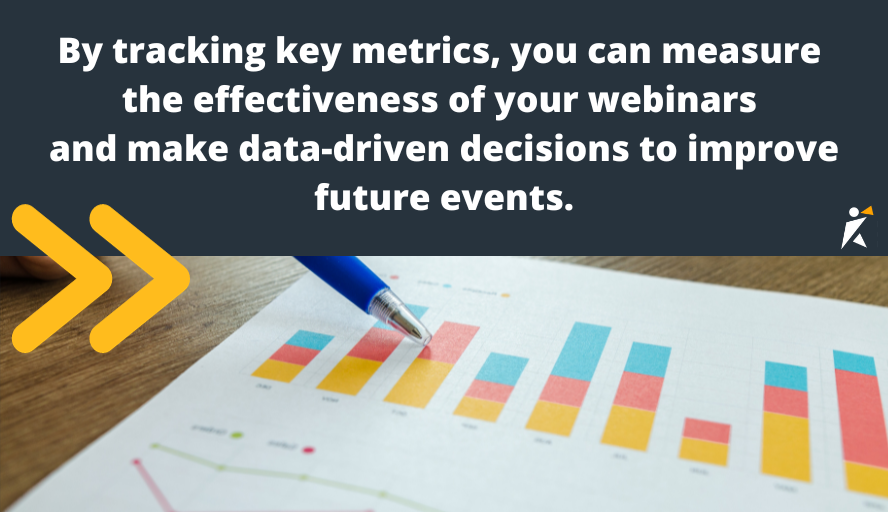How to Get More Insights Into Your Webinar Attendees

Webinars have become an essential tool for businesses and professionals to share knowledge, engage with their audience, and generate leads. However, hosting a successful webinar is not just about the number of attendees or the quality of the content.
To truly maximize the impact of your webinars, you need to dive deeper and gain valuable insights into your webinar attendees. These let you understand their needs, preferences, and behaviors, ultimately allowing you to improve future webinars and drive better results.
Understanding the Importance of Webinar Attendee Insights
Attendee insights play a crucial role in achieving webinar hosting success. By understanding who your attendees are, what they are seeking, and how they engage with your webinar, you can tailor your content to their preferences, enhance your delivery, and create a more personalized experience.
The more you know about your attendees, the better equipped you are to meet their expectations and deliver value that keeps them coming back for more. To truly make an impact and drive results, you need to gather insights from your attendees.
The Role of Attendee Insights in Webinar Success
Attendee insights help you measure the effectiveness of your webinars. By analyzing these insights, you can assess the overall webinar performance, identify areas for improvement, and make data-driven decisions to enhance your future webinars. The insights gained from your attendees can also help you build stronger relationships, increase engagement, and generate meaningful conversations that can positively impact your business.

One of the key benefits of gathering attendee insights is the ability to tailor your content to their preferences. By understanding what your attendees are seeking, you can create webinar topics and presentations that resonate with them. This increases their engagement and enhances their overall experience. When attendees feel that the webinar is specifically designed for them, they are more likely to stay engaged, ask questions, and take action based on the information provided.
Furthermore, attendee insights can help you improve your delivery. By analyzing metrics such as attendance rate and duration of attendance, you can identify patterns and trends that indicate areas for improvement. For example, if you notice a high drop-off rate at a certain point in your webinar, you can review that section and modify it to keep attendees engaged throughout the entire session.
Key Metrics to Consider for Attendee Insights
You should gather attendee insights such as the number of registrants, attendance rate, engagement rate, duration of attendance, and feedback collected. By tracking these metrics, you can assess the overall reach and impact of your webinars and better understand your attendees' level of interest and engagement.
-
The number of registrants indicates the initial interest in your webinar. By tracking this metric, you can evaluate the effectiveness of your promotional efforts and determine if any adjustments are needed to attract a larger audience.
-
Attendance rate tells you how many of the registered attendees showed up for the webinar. A high attendance rate indicates that your webinar topic and promotional messaging resonated with your audience, while a low attendance rate may indicate a need to reevaluate your approach.
-
Engagement rate measures how actively your attendees participate, asking questions, answering polls, or interacting with you and other attendees. A high engagement rate means your webinar captures the attention and interest of your audience, while a low engagement rate means your content should be more interactive and engaging.
-
Duration of attendance tracks how long attendees stayed for the webinar. This provides insights into the overall quality and relevance of your content. If attendees are dropping off early, your webinar may not be meeting their expectations or the content may need to be more concise and focused.
-
Lastly, feedback collected from attendees provides insights into their experience and satisfaction level. By gathering feedback through surveys or post-webinar evaluations, you can identify areas for improvement and modify your next webinars.

By understanding who your attendees are, what they are seeking, and how they engage with your webinar, you can tailor your content, enhance your delivery, and create a more personalized experience. By tracking key metrics such as registrants, attendance rate, engagement rate, duration of attendance, and feedback collected, you can measure the effectiveness of your webinars and make data-driven decisions to improve future events.
Strategies to Gather More Attendee Insights
Now that you understand the importance of attendee insights, let's explore some strategies to collect more valuable data about your webinar attendees.
One effective strategy is to utilize pre-webinar surveys and questionnaires. Before your webinar takes place, consider sending out these surveys to your registered attendees. These surveys can help you gather vital information about their interests, expectations, and challenges. By understanding their needs beforehand, you can tailor your content to their specific requirements and ensure a more personalized experience.
Additionally, utilizing interactive webinar features can greatly enhance your ability to gather insights in real time. Use interactive features such as polls, quizzes, and live chat sessions that provide feedback and engagement from your attendees. Encourage participation and lively discussions to gain further insights into their thoughts and preferences.
Collecting feedback after the webinar is a crucial step in gaining attendee insights, too. Send post-webinar surveys and feedback forms so you can gather their thoughts, suggestions, and overall satisfaction with the webinar experience. This feedback can be invaluable in identifying areas for improvement and addressing any concerns or challenges that your attendees may have faced.
Furthermore, you can explore the use of social media monitoring tools to gather insights about your attendees. By monitoring social media platforms, you can gain a better understanding of their conversations, interests, and preferences related to your webinar topic. You can then tailor your content and marketing efforts to better align with their needs and interests.
An approach to gathering more comprehensive insights about your attendees is by finding their LinkedIn profiles or using their email addresses with a reverse email lookup tool. This can offer additional data on their professional background, skills, endorsements, and network, letting you tailor your webinar content to fit their needs and interests.
Another strategy to consider is conducting post-webinar interviews or focus groups with a select group of attendees. These qualitative research methods provide deeper insights into their experience. By engaging in direct conversations with your attendees, you can uncover practical insights that may not have been captured through surveys or feedback forms.
Analyzing and Interpreting Webinar Attendee Insights
Once you have gathered a wealth of attendee insights, it's time to analyze and interpret the data.
Start by identifying trends in the attendee data. Look for common themes, preferences, or behaviors that emerge across multiple webinars. For example, you might notice that attendees prefer certain topics or formats over others. These let you identify areas to focus on and refine in future webinars.
But it's not just about identifying patterns; it's also about understanding the reasons behind them. Take the time to analyze the data and try to uncover the underlying motivations and drivers behind attendee behavior. This deeper understanding will allow you to make more informed decisions and create more impactful webinars.
Identifying Patterns and Trends
Start by analyzing the attendee demographics such as age, gender, location, and industry. Next, examine the data on attendee engagement. Look at metrics such as the average time spent watching the webinar, the number of questions asked, or the level of interaction with the chat feature. This data can give you insights into the level of interest and engagement among your attendees.
Another element is the feedback provided by the attendees. Look for recurring themes or suggestions that can help you improve your webinars. Pay attention to both positive and negative feedback as they can provide valuable insights into what is working well and what needs improvement.
Making Sense of Attendee Behavior
Examine attendee behavior data to gain a deeper understanding of their engagement during the webinar. Look at metrics such as how long they stayed, which sections they skipped, or if they used any interactive features. This insight helps you identify the most engaging parts of your webinar and make adjustments to optimize future sessions.
Consider conducting surveys or interviews with attendees to gather qualitative data about their experience. This shows their motivations, preferences, and expectations. By combining quantitative and qualitative data, you can develop a comprehensive understanding of attendee behavior.
It's also important to analyze the data over time. Look for trends and changes in attendee behavior across different webinars or over a certain period. This can help you identify shifts in attendee preferences or interests so you can adapt your webinar content accordingly.
Translating Insights into Actionable Steps
Finally, it's essential to translate the insights you have gained into actionable steps. Use the data to inform your content creation, delivery techniques, and webinar strategies. For example, if attendees consistently express interest in a topic, consider developing a series of webinars about that subject matter.
When implementing changes based on the insights you have gathered, it's important to track the impact of those changes, too. Monitor attendee feedback, engagement metrics, and any other relevant data to assess the effectiveness of your adjustments.
Remember, analyzing and interpreting attendee insights is an iterative process. As you gather more data and gain more insights, you can refine your analysis techniques and uncover even more valuable information.
Improving Future Webinars Based on Attendee Insights
With a deep understanding of your webinar attendees and valuable insights at your disposal, it's time to put that knowledge into action and improve future webinars.
Tailoring Content to Attendee Preferences
Now that you have gained insights into your attendees' interests and preferences, use that information to tailor your content accordingly. Make sure your webinar topics align with what your attendees find most valuable and engaging. Consider diversifying your content to cater to different segments of your audience, ensuring a wider appeal and increased attendance rates.
Enhancing Webinar Delivery and Engagement
Use the insights you have gathered to enhance your webinar delivery and overall engagement. Experiment with different formats, interactive features, or visual aids to create a more immersive and dynamic experience. You can refine your delivery techniques and keep your webinars fresh and captivating.
Continuous Learning and Improvement through Insights
In conclusion, getting more insights into your webinar attendees is key to improving your webinar strategy and driving better results. From understanding the importance of attendee insights to gathering and analyzing the data, every step plays a critical role in enhancing your webinars.
By using the insights gained from your attendees, you can tailor your content, improve delivery, and continuously evolve to cater to their changing needs. So, start implementing these strategies today, and uncover the full potential of your webinars!


